| Portuguese VISLSentence AnalysisEdutainmentCorporaDictionariesMachine Translation |
Eckhard Bick
PORTUGUESE SYNTAX
9. Comparatives
Portuguese comparative structures are traditionally divided into three types of comparatives and two types of relative superlative:
- comparative of equality (tão ... como),
- comparative of superiority (mais ... que)
- comparative of inferiority (menos ... que)
- superlative of superiority (o mais ... de)
- superlative of inferiority (o menos ... de).
Syntactically, the connection between the comparative kernel and the comparandum
is established by means of relational particles: - relative adverbs (como,
segundo, conforme, quanto, quão) or relative determiners (quanto,
qual), the subordinating conjunctions que and do_que,
and the preposition de. The relative particles are used for equalitative
comparisons, while que, do_que and de cover both superiority-
and inferiority-comparisons, which we will here lump together under the
term correlative comparisons.
In most cases these
comparandum header particles need a premodifying "hook" at the comparative
kernel (head [H] of the adject-ap [DA:ap] in (a)), to which they are dependency-linked.
But in a few constructions direct comparisons (shaded) do occur (b). In
type (a) constructions the comparandum clause (DAcom:cl) is
an argument of the comparison-hook (mais/menos), in type (b) constructions
it functions as a post-modifier.
As correlative hooks
function the quantifying adverbs mais and menos which denote
the comparative degree of Portuguese adjectives and adverbs, and as equalitative
hooks the adverbs tão, tanto and the determiners tanto,
tal. There are restrictions as to which hook can be combined with which
relational particle, for instance mais/menos - que/do_que, tal - qual,
tanto - quanto, tão - como.
(a)
(b)
Some grammarians would
choose to describe what we call comparandum header, as a preposition (a')
heading a pp (without a verb). Also, the comparandum might be considered
a dependent not of the premodifying comparative hook, but of the comparative
base, yielding a flatter constituent analysis of the adjective group in
question, free of disjunct constituents:
One could argue that
the comparandum in (a) should be analysed as a finite clause, too, that
is, as an elliptic finite clause with a conjunction subordinating
a finite clause with a zero constituent predicator. With a flat ap-analysis,
we get (a''):
(d) Parece mais cansado
do que doente. (Cs)
(e) Na empresa do casal,
investiu mais dinheiro do que o marido. (S)
(f) Na empresa do casal,
investiu mais trabalho do que dinheiro. (Oacc)
(g) Confia tanto em
Deus como na previdência social. (Opiv)
(h) Dormia mais no
escritório do que em casa. (fA)
(i) Costumava exprimir-se
em termos mais eruditos do que bem definidos. (DN)
In (i), if assigned
function, the comparandum body is not a clause level, but a group level
constituent (DN), demonstrating clearly the limits of forced fcl-analyses
and zero-constituents - it doesn't make sense to add [são] to form
do que [são] bem-definidos, since eruditos itself is not
a Cs, but a DN.
In some cases, function
tags for the comparandum body can help express ambiguity, as in (j) where
one doesn't know whether the poor turkey is having lunch or being had for
lunch:
(j) Come mais milho
do que peru. (Oacc vs. S)
A special form of (correlative)
comparative construction occurs in the fixed expression ?por mais [adj]
que [v-fin(subj)]?, where an adjective functions as argument of the preposition
por and is modified by a comparative hook (mais) which governs a subjunctive
(!) comparandum fcl:
In analytic superlative
constructions, the preposition de is used as comparandum header, and
the comparandum body has to be a (collective) nominal. Also, the whole
comparison construction (unless functioning as postnominal to a definite
noun), is preceded by a definite article.
In the case of an adjective
base (a), the article must - since it is inflecting - be considered as
prenominal dependent of the adjective, creating an np in the process (ela
é a mais bonita de todas), rather than an adjp.
In the case of an adverb
base ((b): ela trabalha o mais depressa de todas), the article
doesn't inflect and could be regarded as adnominal dependent of a pronominal
mais, yielding a nominal intensifier (o mais de todas):
(a)
(b)
Only rarely, in the
case of comparatives with a numeral as comparandum body and a noun as comparative
base, do we find both hook and comparandum to the left of the base: mais de 10 anos depois.
On clause level, ordinary
direct comparisons (a) function as adverbials in much the same way as a
certain type of "commenting comparison" (b):
(a) Vivem como
os antigos romanos [viviam].
(b) Segundo/conforme
eles [dizem], pode viajar amanhã mesmo.
In both cases, the
concerning adverbial (underlined) is headed by a word of dubious word class
(in bold face), which for functional reasons could be tagged as both a
preposition or a conjunction, depending on the absence or presence of a
verb within the adverbial constituent. Accordingly, the form category of
the adverbial would change from group (pp) to clause (fcl). In order to
achieve a more homogeneous description, we will choose a third path and
use one (clausal) analysis for all readings of both (a) and (b), calling
both como and segundo/conforme for comparative adverbs, functioning
as clause subordinators (for an acl or fcl, respectively).
Last, there is some
resemblance between hooked comparisons and hooked consecutive constructions:
(a) Canta tão
bem como um rouxinol [canta].
(b) Canta tão
bem que choram os rouxinóis.
In one analysis, the
difference between the two cases is both structural and functional. The
comparandum in (a) is (argument) part of a disjunct DA constituent, while
the "consecutivum" (underlined) in (b) is a clause level adverbial adjunct
(fA).
However, like in (a),
there is still some syntactic link between tão and the
subordinated clause in (b), since tão cannot be omitted:
*canta bem que choram
os rouxinóis.
Also, tão bem
que can be replaced by de maneira que or de modo que or tanto que,
making the presumed adjunct adverbial unisolatable (from the que-clause),
suggesting in stead an analysis where que choram ... is dependent
part (DA/DN) of a larger group constituent (DA:ap [tão/tanto que]
or DP:np [maneira/modo que):
O que acontece que
choram os rouxinóis?
Exercises:
9-1. O filho é mais alto que
o pai.

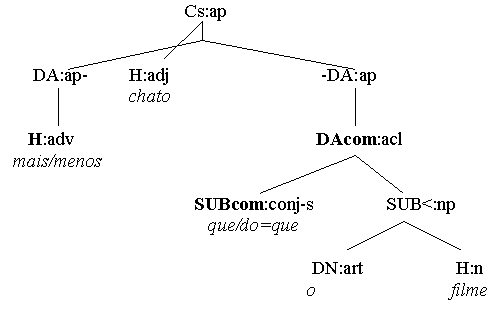

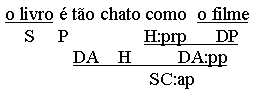



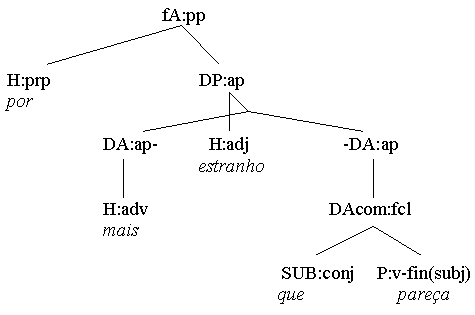

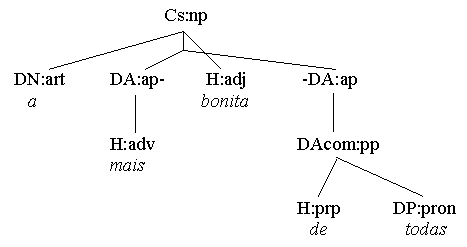
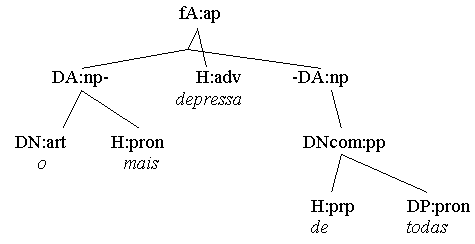
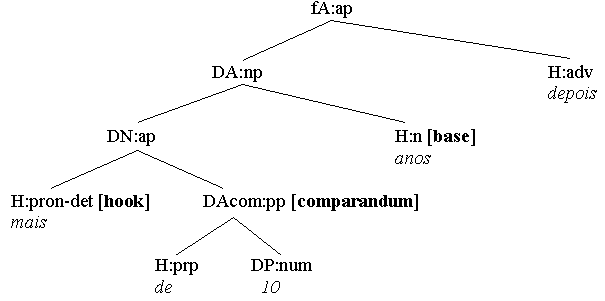
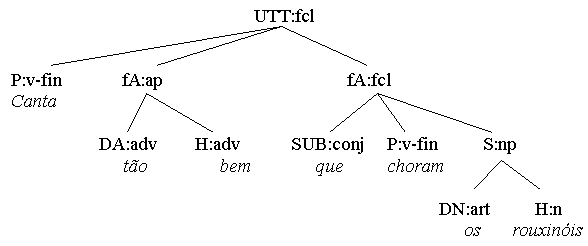
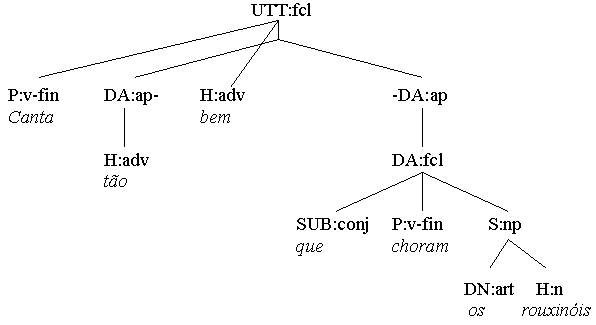
9-2. O filho é tão
alto como o pai.
9-3. Não sou uma mulher como
as que existem na terra.
9-4. Ele fala como ele pensa.
9-5. É tão avaro como
rico.
9-6. Tinha menos dinheiro para gastar
do que o seu irmão.
9-7. Bom que seja o rapaz não
é nenhum santo.
9-8. Comeu tanta comida que nada
sobrou para a irmã.
9-9. Ficou tal qual era antes.
9-10. Estamos nos tornando o mais
pobre dos países urbanos industriais.
9-11. Por mais contraditório
que pareça, o velho funcionário da VARIG não quis
viajar de avião.
9-12. Na época, Londres já
era uma cidade de não mais de 100.000 habitantes.
9-13. Trouxeram cerca de 10 bilhões
de dólares, conforme se estima.
9-14. Foi descongelado como herói
do empresariado.